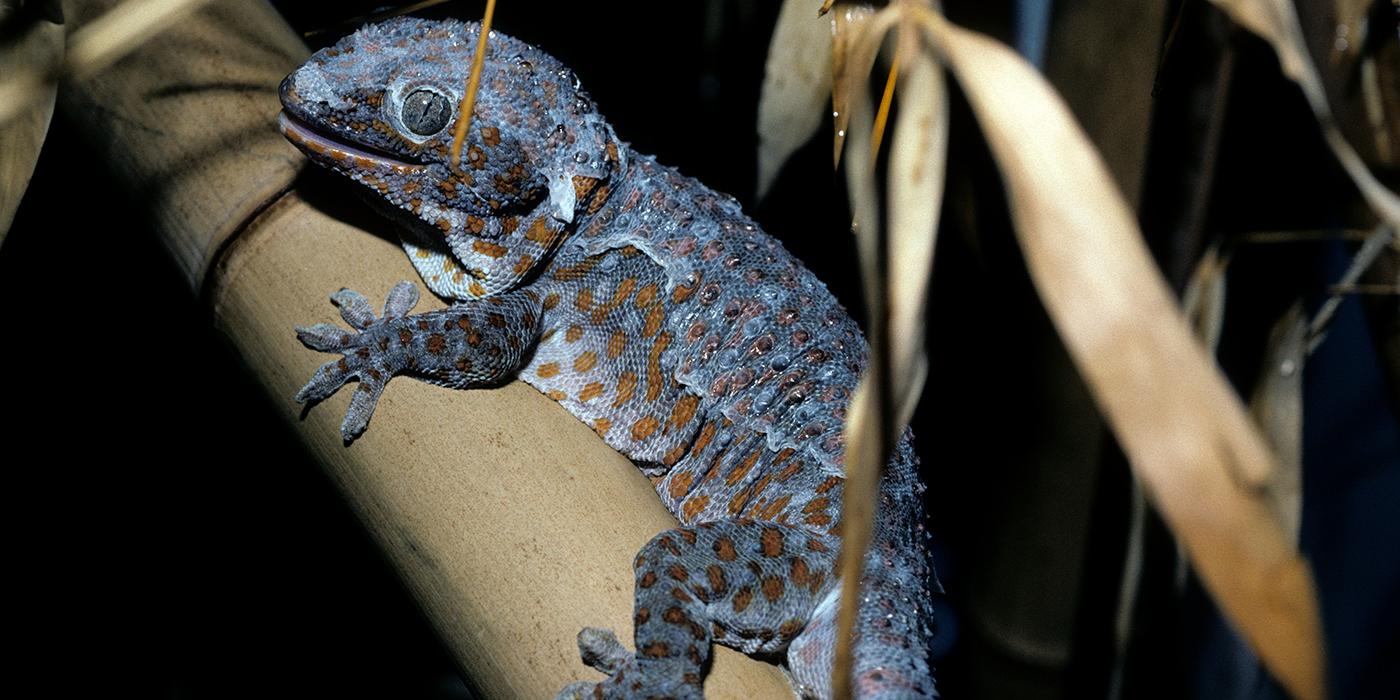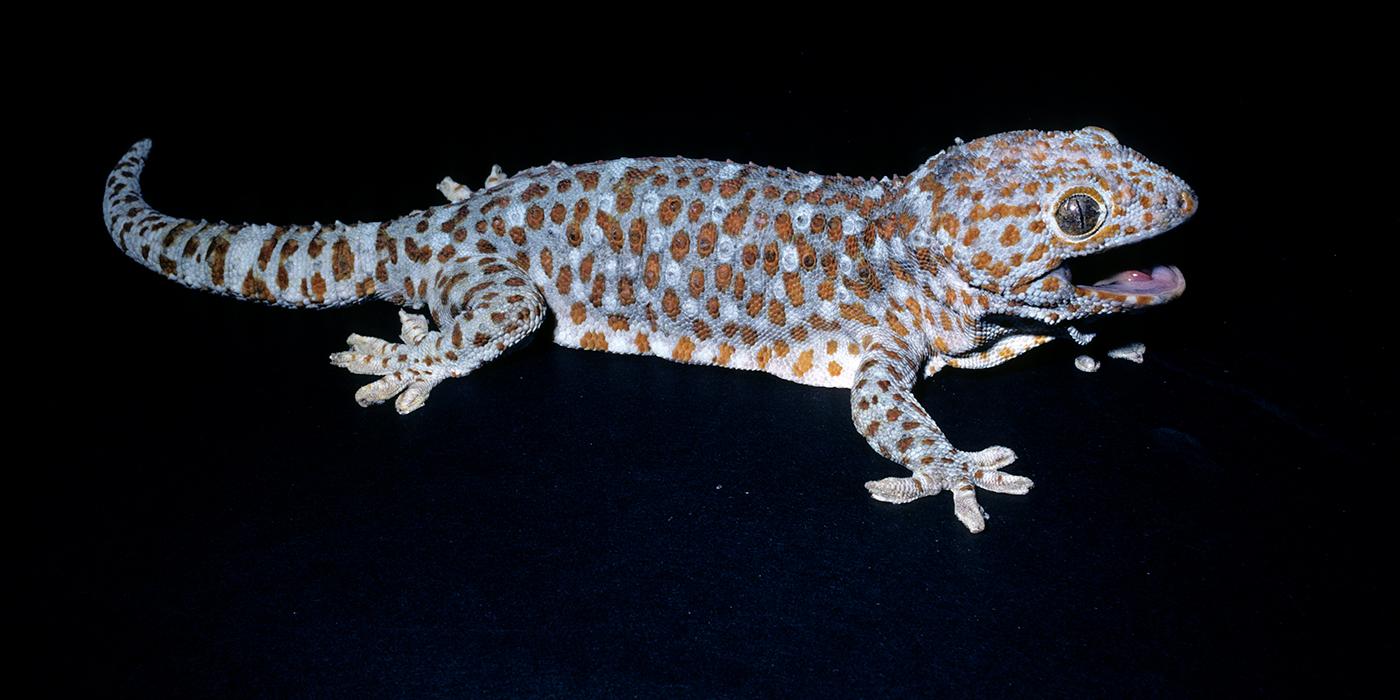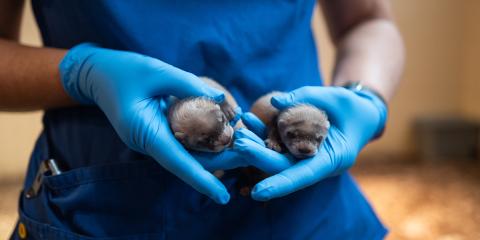Physical Description
Tokay geckos have thick, cylindrical bodies, with heads set apart from their necks. Their limbs are well-defined and powerful, and their bodies are covered in spots.
Two variants of tokay geckos exist: a red-spotted and a black-spotted. In the red-spotted tokay gecko, these spots range from light yellow to red and overlay a bluish or grayish body. Their coloration is important for camouflage, and they can actually lighten or darken their skin color to better blend in with their environment.
Skin folds keep these geckos from casting a shadow while resting on a tree. The folds open up completely, blurring the line between their body and the tree.
The tokay gecko can cast off its tail in defense, breaking it off at several sections. The cast-off portion of the tail continues to move violently for several minutes, giving the gecko time to escape. The gecko’s tail regenerates in approximately three weeks, although it typically does not grow as long as the original.
Geckos are known for their incredible grip and ability to “stick” to surfaces. The grip force of a tokay gecko is especially impressive and can support about 450 pounds. They adhere to vertical and overhanging surfaces using setae, fine filaments that create more surface area and form molecular bonds. The lizards can hold onto a vertical surface with as little as one toe at a time
They are also lightning fast and have a very strong bite that can draw blood. When bitten by a tokay gecko, as with other reptiles, it is best not to tug or pull; this will cause the animal to tighten its grip. Instead, place all four limbs on an even surface near a potential “retreat” and wait for the animal to let go.
The tokay gecko has visible ear holes on either side of its head. It has the remains of a small, rudimentary “third eye,” known as the median eye or parietal eye, which is associated with the pineal gland. This feature is not present in other geckos but is found in diurnal species of the two reptile orders Squamata and Rynchocephelia. It does not capture images but is highly sensitive to light, leading scientists to believe that it helps regulate activity in different light conditions.
The gecko’s other two eyes are large, prominent and have vertically-slit pupils that are brownish in color. The eyelids of these two eyes are fused together and transparent.
It uses its nose to breathe and smell. A large number of sensory cells on a membrane within the nostrils helps the gecko detect scents. They also use their tongues to carry scent particles to the Jacobson’s organ (a patch of sensory cells) to “taste” the air.
Size
Tokay geckos are one of the largest geckos alive today. Males range from about 13-16 inches (35-40 centimeters) and females about 8-12 inches (20-30 centimeters). Females are not only smaller than males but also duller in color.
Native Habitat
Tokay geckos are found across southeast and east Asia. The two types of tokay geckos, red-spotted and black-spotted, vary in distribution within this range. Black-spotted tokay geckos are more likely to be found in northern Vietnam and mainland China, specifically in the Guanxi, Guangdang and Southern Yunnan Provinces.
Red-spotted tokays are more widespread in southeast Asia, with naturally occurring populations reported in Bangladesh, Nepal, the Philippines, Thailand, Indonesia and the Indo-Australian Archipelago.
These geckos are also found beyond Asia, but these populations became established due to the pet trade or accidental transport via cargo shipments. In the U.S., tokay gecko populations can be found in Hawaii and Florida. Belize, Martinique and the Lesser Antilles also have tokay geckos, which are considered a pest species. They have been found in Madagascar and have been transported to North America, Singapore, Malaysia and Europe for medicinal purposes.
Tokay geckos are arboreal. They live in tropical rainforests, rock crevices or manmade environments with a variety of microhabitats. Black-spotted tokays are more likely to be found in rocky environments, while red-spotted tokay geckos are more likely to be found in lowland or submontane rainforests.
In some areas, geckos have a mutualistic relationship with people. A gecko may shelter in the ceilings and walls of a home, consuming undesirable insects and other prey.
Lifespan
Communication
Tokay geckos communicate vocally, using calls to find members of the opposite sex during the breeding season and as a means of defense. They emit a hissing or croaking noise when threatened and, if not defending a territory, are likely to flee. If cornered, they will deliver a swift, severe bite.
Food/Eating Habits
These geckos primarily eat invertebrates, including moths, locusts, grasshoppers, beetles, cockroaches, termites, crickets, mosquitos and spiders. They may also eat small rats, mice and snakes. Tokay geckos are solitary, nocturnal hunters and are more likely to sit and wait for prey than to actively forage, though they do maintain a foraging area.
Tokay geckos are large, can consume a lot of prey and thrive in manmade environments, so they are sometimes utilized for the control of insects that are considered pests.
At the Smithsonian's National Zoo, they eat crickets, cockroaches and mealworms.
Sleep Habits
Social Structure
Tokay geckos are solitary creatures; they only encounter the opposite sex during the breeding season. They will defend their territory against intruders, ensuring less competition for food. Males generally guard the territory, though it is sometimes watched by females.
Reproduction and Development
Their breeding season lasts about four to six months. Males use a call, which can be heard several meters away, to attract a mate. This loud "to-kay" sound is repeated multiple times in a crescendo and is the origin of this gecko's common name.
During the breeding season, tokay geckos release a liquid from the femoral pores located on their upper hind legs. This secretion is thought to attract a mate or to make copulation easier. Males mate frequently with females, often grasping them with their mouths.
Mating takes place every month, allowing females to repeatedly lay eggs throughout the breeding season. When the female finds a laying site, she affixes her hard-shelled eggs to a solid foundation where they are guarded by both parents until they hatch. The eggs are oval-shaped and range from 3-45 millimeters long.
Hatchlings are 2-3 inches (5-7.5 centimeters) long. Upon hatching, they eat their outer covering of skin. They reach sexually maturity after about one year. Hatchlings are aggressive and will readily bite, just like their parents.
Conservation Efforts
Tokay geckos have some protections in different countries throughout their range. While considered common in Cambodia and Thailand, the Chinese Red Data Book lists tokay geckos as an endangered species due to the over-harvesting of wild animals for use in traditional medicine and as pets. Likewise, Vietnam's Red Data Book lists them as a threatened species.
In Malaysia, tokay geckos became a protected species in 2010, and harvesters must have a government-issued permit. However, poor communication, as well as low awareness and enforcement of the law have led to the use of fraudulent permits. Reports from Nepal indicate that tokay geckos are rare, while populations have declined by 50 percent since 2009. Bangladesh does not have protections in place for this species.
While evidence does not support all of these claims, in traditional Chinese medicine, tokay geckos are believed to treat a number of ailments, such as asthma, cancer, diabetes, kidney issues and skin diseases. The transport of dried tokay geckos is common across southeast Asia and to the U.S., and the over-extraction of this animal is leading to its decline.
In 2009, tokay geckos became a subject of interest for research in novel medicines following rumors that agents in its skin could cure HIV/AIDS. There is no evidence to support this claim, but there was a spike in trafficking of tokay geckos across southeast Asia (especially into Malaysia) and to Europe and North America.
Tokay geckos are also a common pet, with most coming from Java, Indonesia, where the law limits the harvest of geckos and restricts the transport of tokays as live animals for the pet trade. While this trade is legal, many breeders and private sellers across Southeast Asia have unregulated operations, sell wild-caught geckos and promote the trade of live animals across borders that prohibit this activity.
Help this Species
- Practice ecotourism by being an advocate for the environment when you’re on vacation. During your travels, support, visit or volunteer with organizations that protect wildlife. Shop smart too! Avoid buying products made from animals, which could support poaching and the illegal wildlife trade.
- Choose your pets wisely, and do your research before bringing an animal home. Exotic animals don’t always make great pets. Many require special care and live for a long time. Tropical reptiles and small mammals are often traded internationally and may be victims of the illegal pet trade. Never release animals that have been kept as pets into the wild.
- Are you a student? Did you love what you learned about this animal? Make it the topic of your next school project, or start a conservation club at your school. You'll learn even more and share the importance of saving species with classmates and teachers, too.




